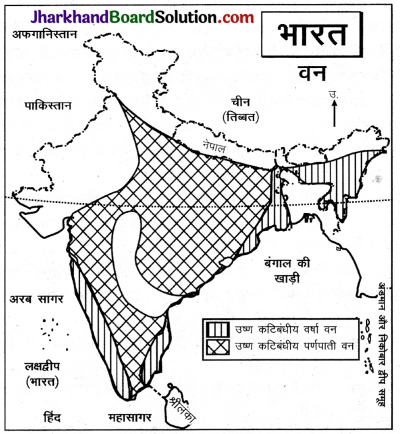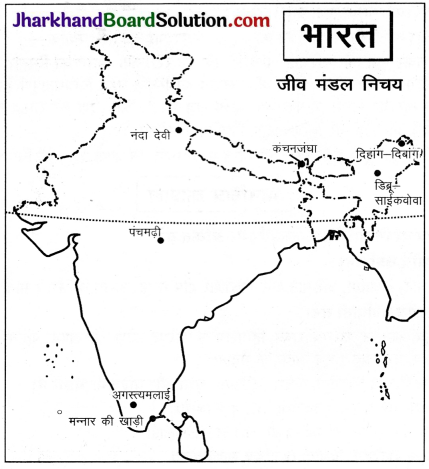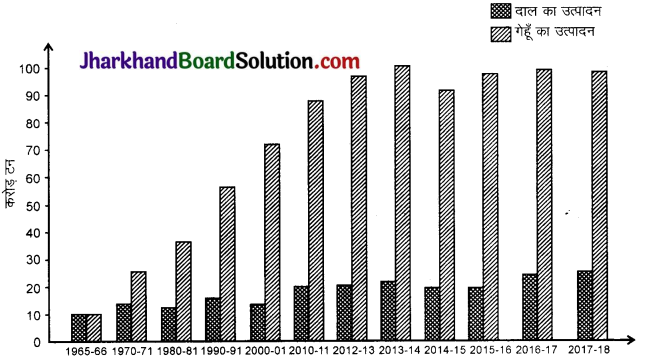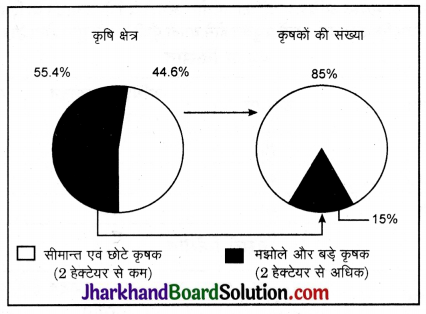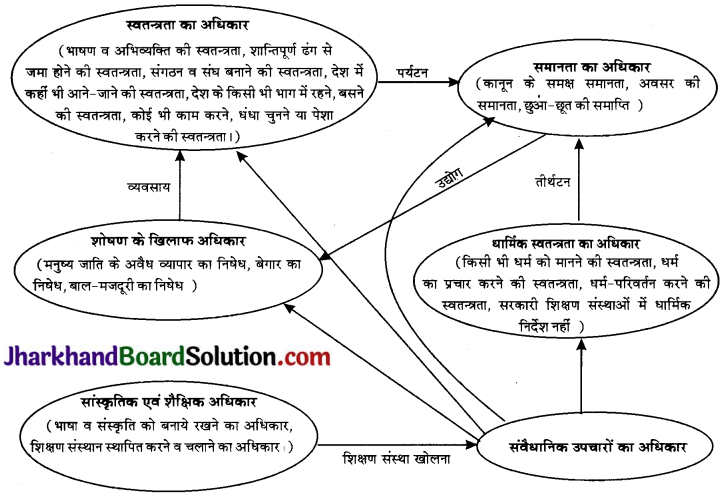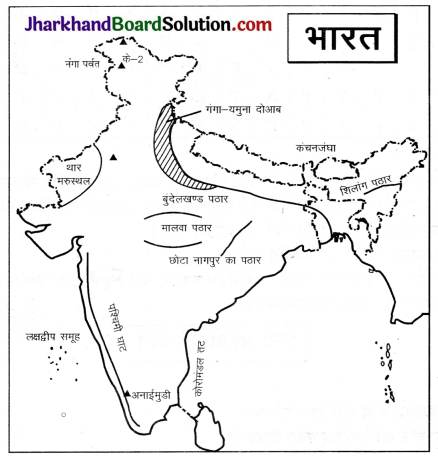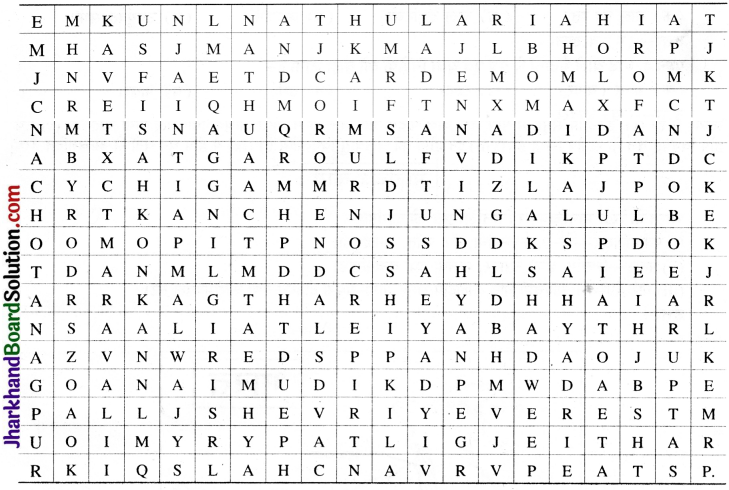JAC Board Class 9th Social Science Solutions Civics Chapter 3 चुनावी राजनीति
JAC Class 9th Civics चुनावी राजनीति InText Questions and Answers
विद्यार्थियों हेतु आवश्यक निर्देश:
पाठ्य-पुस्तक के इस अध्याय में विभिन्न पृष्ठों पर लड़के/लड़की के कार्टून चित्रों के नीचे अथवा खुद करें, खुद सीखें शीर्षक से बॉक्स में अथवा ‘कार्टून बूझें’ शीर्षक के नीचे अथवा कहाँ पहुँचे? क्या समझे? शीर्षक से बॉक्स में प्रश्न दिए हुए हैं। इन प्रश्नों के क्रमानुसार उत्तर निम्न प्रकार से हैं
पाठ्य-पुस्तक पृष्ठ सं.- 37
प्रश्न 1.
क्या अधिकांश नेता अपने चुनावी वायदे पूरा करते हैं?
उत्तर:
अधिकांश नेता चुनाव में जीत जाने के बाद सत्ता की राजनीति में लगे रहते हैं। कुछ हद तक सत्ता में आने वाली पार्टियाँ अपने घोषणा-पत्र में किए गये वायदों पर अमल करती हैं। विजयी नेता, जनता द्वारा पूछे जाने पर सरकार द्वारा (यदि नेता सत्ताधारी पार्टी का है) किये गये कार्यों को अपने द्वारा करवाया जाना बताकर मुक्ति पा लेते हैं और अपनी जेबें भरने में लगे रहते हैं।
प्रश्न 2.
क्या आपको मालूम है आपके राज्य में विधानसभा के पिछले चुनाव कब हुए ? आपके इलाके में पिछले पाँच वर्षों में और कौन-से चुनाव हुए हैं? इन चुनावों के स्तर ( राष्ट्रीय, विधानसभा, पंचायत वगैरह), उनके होने का समय और उसमें आपके क्षेत्र से चुने गए व्यक्ति के पद (सांसद, विधायक, पार्षद वगैरह) को भी दर्ज करें।
उत्तर:
छात्र, इस प्रश्न को अध्यापक की सहायता से स्वयं हल करें।
पाठ्य-पुस्तक पृष्ठ सं.- 38
प्रश्न 3.
जगदीप और नवप्रीत ने इस कथा को पढ़ा और निम्नलिखित निष्कर्ष निकाले।क्या आप बता सकते हैं कि इनमें से कौन-से निष्कर्ष सही हैं और कौन-से गलत। ( या फिर इस कथा में दी गई सूचनाओं के आधार पर सही-गलत का फैसला नहीं हो सकता)
1. चुनाव से सरकारी नीतियों में बदलाव हो सकता है।
2. राज्यपाल ने देवीलाल के भाषणों से प्रभावित होकर उन्हें मुख्यमन्त्री बनने का न्यौता दिया।
3. लोग हर शासक दल से नाराज रहते हैं और हर अगले चुनाव में उसके खिलाफ वोट देते हैं।
4. चुनाव जीतने वाली पार्टी सरकार बनाती है।
5. इस चुनाव से हरियाणा के आर्थिक विकास में काफी मदद मिली।
6. अपनी पार्टी के चुनाव हारने के बाद कांग्रेसी मुख्यमन्त्री को इस्तीफा देने की जरूरत नहीं थी।
उत्तर:
- सही,
- गलत,
- अपर्याप्त सूचना,
- सही,
- अपर्याप्त सूचना,
- गलत।
पाठ्य-पुस्तक पृष्ठ सं.- 36
प्रश्न 4.
हमने देखा कि लोकतन्त्र के लिए चुनाव क्यों जरूरी हैं, पर गैर-लोकतान्त्रिक देशों के शासकों को भी चुनाव कराने की जरूरत क्यों पड़ती है?
उत्तर:
गैर-लोकतान्त्रिक देशों में अपने शासन तथा विधायिका की वैधानिकता का जनता द्वारा अनुमोदन करवाने के लिए शासकों को चुनाव कराने की आवश्यकता होती है।
पाठ्य-पुस्तक पृष्ठ सं.- 38
प्रश्न 5.
यहाँ दिए दोनों कार्टूनों को ध्यान से देखें। प्रत्येक कार्टून क्या संदेश देता है, इसे अपने शब्दों में लिखें। अपनी कक्षा में चर्चा करें कि इनमें कौन-सा कार्टून आपके अपने इलाके की असलियत के करीब है। मतदाता और उम्मीदवार के सम्बन्धों पर चुनाव का असर बताने वाला एक कार्टून खुद बनाएँ।
उत्तर:
बायीं तरफ वाले कार्टून से यह संदेश प्राप्त होता है कि नेताओं के ज्ञान, विचार, वायदा, योजना आदि सभी निरर्थक हैं, यदि उन्हें जीत के लिए पर्याप्त वोट प्राप्त नहीं होते हैं। दाहिनी तरफ दिखाए गये कार्टून से यह संदेश मिलता है कि चुनाव अभियानों के दौरान राजनेताओं द्वारा कई वायदे किये जाते हैं। किन्तु, चुनाव जीतने के बाद जब उन्हें पद प्राप्त हो जाता है, तो उनके पास अपने किये वायदों को पूरा करने के लिए समय नहीं होता। नोट-चर्चा तथा कार्टून बनाने का कार्य छात्र अध्यापक की सहायता से स्वयं करें।
पाठ्य-पुस्तक पृष्ठ सं.- 39
प्रश्न 6.
गुलबर्गा लोकसभा निर्वाचन क्षेत्र की सीमा और गुलबर्गा जिले की सीमा में अन्तर क्यों है?
उत्तर:
गुलबर्गा लोकसभा निर्वाचन क्षेत्र तथा जिले की सीमा में अन्तर है क्योंकि सम्पूर्ण कर्नाटक राज्य जनसंख्या के अनुसार समान लोकसभा निर्वाचन क्षेत्रों में विभाजित है। सम्पूर्ण गुलबर्गा जिले की जनसंख्या राज्य के प्रत्येक लोकसभा क्षेत्र के लिए निर्धारित जनसंख्या से अधिक है।

प्रश्न 7.
अपने लोकसभा निर्वाचन क्षेत्र का ऐसा ही नक्शा बनाइए।
उत्तर:
छात्र, अध्यापक की सहायता से स्वयं बनाएँ।
प्रश्न 8.
गुलबर्गा लोकसभा निर्वाचन क्षेत्र में विधानसभा के कितने क्षेत्र हैं?
उत्तर:
गुलबर्गा लोकसभा निर्वाचन क्षेत्र में 8 विधानसभा निर्वाचन क्षेत्र आते हैं।
प्रश्न 9.
क्या आपके लोकसभा क्षेत्र में विधानसभा की इतनी ही सीटें हैं?
उत्तर:
छात्र, इस प्रश्न को अध्यापक की सहायता से स्वयं हल करें।
पाठ्य-पुस्तक पृष्ठ सं.- 40
प्रश्न 10.
पंचायतों की तरह क्या हम संसद और विधानसभाओं की एक-तिहाई सीटें महिलाओं के लिए आरक्षित नहीं कर सकते?
उत्तर:
समाज की लगभग आधी जनसंख्या महिलाओं की है। उन्हें राज्य विधान सभा की सीटों अथवा संसदीय सीटों में एक-तिहाई सीटों पर आरक्षण देना चाहिए। जिससे वे संसदीय मंच से अपनी समस्याओं के लिए आवाज उठाने तथा उनका समाधान ढूँढ़ने का पूरा-पूरा प्रयत्न करें।
पाठ्य-पुस्तक पृष्ठ सं.- 41
प्रश्न 11.
ऊपर दिए नक्शे को देखिए और निम्नलिखित सवालों का जवाब दीजिएनोट-विद्यार्थी नक्शे को पाठ्य-पुस्तक के इस अध्याय में पृष्ठ संख्या 67 पर देखें।
1. आपके राज्य और इसके दो पड़ोसी राज्यों में लोकसभा निर्वाचन क्षेत्रों की संख्या कितनी है?
उत्तर:
राजस्थान = 25, उत्तर प्रदेश = 80, मध्य प्रदेश = 29, उत्तराखण्ड = 5.
2. किन-किन राज्यों में लोकसभा के 30 से ज्यादा निर्वाचन क्षेत्र हैं?
उत्तर:
वे राज्य जिनमें लोकसभा सीटों की संख्या 30 से अधिक है-उत्तर प्रदेश, आन्ध्र प्रदेश, बिहार, महाराष्ट्र, तमिलनाडु एवं पश्चिमी बंगाल हैं।
3. कुछ राज्यों में निर्वाचन क्षेत्रों की संख्या ज्यादा क्यों है?
उत्तर:
इन राज्यों में जनसंख्या अधिक है। इस कारण मतदाताओं की संख्या बहुत ज्यादा है। अतः इनके लिए आवंटित सीटों की संख्या ज्यादा है।
4. कुछ निर्वाचन क्षेत्र इलाके के हिसाब से छोटे और कुछ बहुत बड़े क्यों हैं?
उत्तर:
मतदाताओं की संख्या के आधार पर प्रत्येक निर्वाचन क्षेत्र के क्षेत्रफल को निर्धारित किया जाता है। ऐसा इसलिए है कि समान आबादी के लिए प्रतिनिधि की संख्या समान हो। यहाँ क्षेत्रफल का कोई महत्व नहीं होता। सम्भव है कि एक छोटे से क्षेत्र की जनसंख्या एक बड़े क्षेत्र की जनसंख्या के बराबर हो। यही कारण है कि कुछ निर्वाचन क्षेत्र बहुत छोटे होते हैं, कुछ बहुत बड़े होते हैं।
5. अनुसूचित जातियों और अनुसूचित जनजातियों के लिए आरक्षित निर्वाचन क्षेत्र पूरे देश में बिखरे हैं या कुछ इलाकों में इनकी संख्या ज्यादा है?
उत्तर:
अनुसूचित जाति/जनजाति के लिए निर्वाचन क्षेत्र उनकी जनसंख्या के आधार पर आरक्षित किये जाते हैं। अतः इनके लिए आरक्षित निर्वाचन क्षेत्र पूरे देश में समान रूप से वितरित नहीं हैं, बल्कि कुछ क्षेत्रों में इनके निर्वाचन क्षेत्र अधिक हैं तो कुछ में निर्वाचन क्षेत्र कम हैं।
पाठ्य-पुस्तक पृष्ठ सं.- 42
प्रश्न 12.
उम्मीदवारों को अपनी सम्पत्ति का ब्यौरा देने की जरूरत क्यों होती है?
उत्तर:
सर्वोच्च न्यायालय के फैसले के अनुसार प्रत्येक मतदाता को अपने प्रतिनिधि के बारे में निम्नलिखित सूचनाएँ प्राप्त करने का अधिकार है
- चल तथा अचल सम्पत्ति का विवरण
- सरकारी ऋण
- शैक्षिक योग्यता
- कर की स्थिति
- आपराधिक पृष्ठभूमि
- आमदनी।
पाठ्य-पुस्तक पृष्ठ सं.- 44
प्रश्न 13.
भारत की चुनाव प्रणाली की कुछ विशेषताएँ और कुछ सिद्धान्त दिये गये हैं। इनके सही जोड़े बनाएँ।
| सिद्धान्त | चुनाव प्रणाली की विशेषता |
| 1. सार्वभौम वयस्क मताधिकार | हर चुनाव क्षेत्र में लगभग बराबर मतदाता |
| 2. कमजोर वर्गों को प्रतिनिधित्व | 18 वर्ष और उससे ऊपर के सभी को मताधिकार |
| 3. खुली राजनीतिक प्रतिद्वंद्विता | सभी को पार्टी बनाने या चुनाव लड़ने की आजादी |
| 4. एक मत, एक मोल | अनुसूचित जातियों/जनजातियों के लिए सीटों का आरक्षण। |
प्रश्न 14.
पिछले लोकसभा चुनाव में आपके चुनाव क्षेत्र में चुनाव अभियान कैसा चला था? उम्मीदवारों और पार्टियों ने क्या-क्या कहा और क्या-क्या किया, इसकी सूची तैयार कीजिए।
उत्तर:
छात्र, इस प्रश्न को अपने अध्यापक की सहायता से स्वयं हल करें।
पाठ्य-पुस्तक पृष्ठ सं.- 46
प्रश्न 15.
मतदान केन्द्रों और मतगणना केन्द्रों पर पार्टी या उम्मीदवार के एजेंट क्यों मौजूद होते हैं?
उत्तर:
क्योंकि किसी पार्टी अथवा मतदाता द्वारा मतदान के दौरान किए जाने वाली किसी प्रकार की धाँधली को रोका जा सके। मतगणना के दौरान मतगणना केन्द्र पर होने वाली किसी भी प्रकार की अनियमितता पर नजर रखना एवं अनियमितता या गड़बड़ी होने पर उसे सम्बन्धित अधिकारियों के सामने लाया जा सके। (पाठ्य-पुस्तक के पृ. सं. 49 पर दी गयी सारणी को देखकर प्र. नं. 17, 18 के उत्तर दीजिए।)

प्रश्न 16.
अपना मत डालने वाले मतदाताओं का प्रतिशत कितना था?
उत्तर:
कुल 57.54 प्रतिशत मतदाताओं ने अपना मतदान किया।
प्रश्न 17.
क्या चुनाव जीतने के लिए यह जरूरी है कि किसी व्यक्ति को डाले गये मतों में से आधे से अधिक मत मिलें?
उत्तर:
नहीं, जो उम्मीदवार सम्बन्धित क्षेत्र में सर्वाधिक मत प्राप्त करता है, उसे ही विजयी घोषित किया जाता है। चाहे उसने एक ही मत अधिक प्राप्त किया हो।
प्रश्न 18.
इनमें कौन-सा काम आदर्श चुनाव संहिता का उल्लंघन है, कौन-सा नहीं?
1. मतदान की तारीख से पहले मन्त्री द्वारा अपने निर्वाचन क्षेत्र के लिए नई रेलगाड़ी को हरी झण्डी दिखाकर रवाना करना।
2. एक उम्मीदवार ने वायदा किया कि चुने जाने पर वह अपने निर्वाचन क्षेत्र में नई रेलगाड़ी चलवायेगा।
3. एक उम्मीदवार के समर्थकों द्वारा मतदाताओं को एक मन्दिर में ले जाकर उनसे उसी उम्मीदवार को वोट देने की शपथ दिलाना।
4. किसी उम्मीदवार के समर्थकों द्वारा झुग्गी बस्ती में वोट के वायदे लेकर कंबल बाँटना।
उत्तर:
- आदर्श चुनाव संहिता का उल्लंघन है।
- आदर्श चुनाव संहिता का उल्लंघन नहीं है।
- आदर्श चुनाव संहिता का उल्लंघन है।
- आदर्श चुनाव संहिता का उल्लंघन है।
पाठ्य-पुस्तक पृष्ठ सं.- 47
प्रश्न 19.
चुनाव आयोग के पास इतनी शक्ति क्यों है ? क्या यह लोकतन्त्र के लिए अच्छा है?
उत्तर:
चुनाव को स्वतन्त्र एवं निष्पक्ष कराने के लिए ही चुनाव आयोग को इतनी शक्ति दी गई है। यह लोकतन्त्र के लिए अच्छा है।
पाठ्य-पुस्तक पृष्ठ सं.- 48
प्रश्न 20.
इन सुर्खियों को ध्यान से पढ़िए और पहचानिए कि स्वतन्त्र और निष्पक्ष चुनाव के लिए चुनाव आयोग किन शक्तियों का प्रयोग कर रहा है।
1. चुनाव आयोग ने 14वीं लोकसभा के गठन की अधिसूचना जारी की।
उत्तर:
14वीं लोकसभा के चुनाव सम्बन्धी सभी तारीखों तथा सीमाओं की घोषणा कर दी गई है। अतः विभिन्न राजनीतिक दल अपनी चुनावी तैयारी प्रारम्भ कर दें।
2. बिहार के चुनाव में मतदान के लिए फोटो पहचान-पत्र अनिवार्य।
उत्तर:
कोई मतदाता जब मतदान के लिए जाता है तो मतदाताओं का मतदान के लिए मतदाता पहचान-पत्र दिखाना जरूरी है अतः बिहार चुनाव में मतदाता को अपना पहचान-पत्र दिखाना अनिवार्य है। इस घोषणा द्वारा आयोग ने चुनाव हित में फैसला लेने सम्बन्धी शक्ति का प्रयोग किया है।
3. चुनाव आयोग ने चुनाव खर्च पर नकेल कसी।
उत्तर:
चुनाव आयोग ने प्रत्येक संसदीय तथा विधान सभा सीट के लिए उम्मीदवारों द्वारा खर्च की जाने वाली राशि की सीमा तय कर दी है, क्योकि कुछ राजनीतिक दल या उम्मीदवार जिसके पास अधिक संसाधन हैं, इसका फायदा उठा सकते हैं। आयोग ने निष्पक्ष चुनाव कराने के लिए अपने अधिकार का प्रयोग किया है।
4. चुनाव आयोग का एक और गुजरात दौरा, चुनावी तैयारियों का जायजा लिया।
उत्तर:
गुजरात में मतदान केन्द्रों पर कब्जा तथा धाँधली होने की सम्भावना सम्बन्धी खबरों के कारण वहाँ की चुनावी व्यवस्था की समीक्षा के लिए आयोग ने एक और दौरा किया। आयोग, निष्पक्ष एवं स्वतन्त्र चुनाव कराने की अपनी शक्ति का प्रयोग कर रहा है।
5. चुनाव आयोग ने गृह मन्त्रालय के चुनाव सुधार सम्बन्धी सुझाव नकारे।
उत्तर:
चुनाव आयोग स्वतन्त्र और निष्पक्ष चुनाव कराने के लिए जिम्मेदार है। इस सम्बन्ध में सारे अन्तिम फैसले वही लेता है। वह किसी भी सुझाव को न मानने के लिए स्वतन्त्र है। इसलिए उसने गृह मन्त्रालय का चुनाव सुधार सम्बन्धी सुझाव नहीं माना।
6. चुनाव के गुप्त खर्च पर चुनाव आयोग की नजर।
उत्तर:
चुनाव आयोग चाहता है कि देश में रहने वाला प्रत्येक व्यक्ति चाहे अमीर हो या गरीब, चुनाव लड़ सके, इसलिए चुनाव में खर्च करने की एक सीमा निर्धारित कर दी गई है। उससे अधिक खर्च करने पर उम्मीदवार को चुनाव के लिए अयोग्य घोषित कर दिया जायेगा।
7. उच्च न्यायालय ने चुनाव आयोग से अपराधी नेताओं पर रोक लगाने को कहा।
उत्तर:
आपराधिक पृष्ठभूमि वाले नेताओं को चुनाव लड़ने की आज्ञा नहीं दी जानी चाहिए। प्रत्येक ऐसे उम्मीदवार को उसके खिलाफ चल रहे गम्भीर आपराधिक मुकदमों का ब्यौरा वैधानिक रूप से घोषित करना पड़ेगा।
8. चुनाव आयोग को हरियाणा के नए पुलिस प्रमुख की नियुक्ति स्वीकार।
उत्तर:
सरकार ने आयोग के निर्देशानुसार वर्तमान पुलिस प्रमुख को स्थानान्तरित किया है। आयोग ने यहाँ निष्पक्ष चुनाव के लिए निष्पक्ष अधिकारी के स्थानान्तरण या नियुक्ति सम्बन्धी अपनी शक्ति का उपयोग किया है।
9. चुनाव आयोग ने 398 मतदान केन्द्रों पर फिर से वोट डालने के आदेश दिए।
उत्तर:
अगर किसी मतदान केन्द्र पर बूथ कब्जा या लूट अथवा धन या शक्ति के प्रयोग की पुष्टि होती है तो चुनाव आयोग का अधिकार है कि वह वहाँ से रिपोर्ट मँगवाए तथा आरोप की पुष्टि होने पर पूर्व मतदान को खारिज कर पुनर्मतदान का आदेश जारी करे। इसलिए आयोग ने 398 मतदान केन्द्रों पर फिर से वोट डालने के आदेश दिए।
10. राजनीतिक विज्ञापनों पर सेंसर का अधिकार हो-चुनाव आयोग।
उत्तर:
चुनाव के समय राजनीतिक पार्टियाँ एक-दूसरे को बदनाम करने के लिए राजनीतिक विज्ञापनों का सहारा लेती हैं, इसलिए आयोग ने स्वतन्त्र एवं निष्पक्ष चुनाव कराने की अपनी शक्ति का प्रयोग करते हुए केवल उन्हीं विज्ञापनों को लगाने की अनुमति दी, जो दूसरों पर आरोप नहीं लगाते।
11. ‘एक्जिट पोल’ पर प्रतिबन्ध लगाने की फिलहाल कोई योजना नहीं-चुनाव आयोग।
उत्तर:
चुनाव के दौरान टी. वी. तथा रेडियो के संवाददाताओं द्वारा सर्वे करके यह अनुमान लगाया जाता है कि मतदाता किस पार्टी को अधिक मत दे रहे हैं इसे ही एक्जिट पोल कहा जाता है। चूँकि चुनाव कई चरणों में होता है अतः अन्य चरणों के मतदान पर इस प्रकार के प्रसारण से असर पड़ सकता है, चुनाव आयोग के पास एक्जिट पोल पर प्रतिबन्ध लगाने की फिलहाल कोई योजना नहीं है।
पाठ्य-पुस्तक पृष्ठ सं.- 49
प्रश्न 21.
अपने परिवार के जो सदस्य मतदाता हैं उनसे पूछे कि उन्होंने पिछले लोकसभा या विधानसभा चुनाव में वोट दिया था या नहीं? अगर उन्होंने वोट नहीं दिया हो तो उनसे इसका कारण पूछिए।अगर उन्होंने मतदान किया हो तो उनसे पूछिए कि उन्होंने किस पार्टी और किस उम्मीदवार को वोट दिया और क्यों दिया। उनसे यह भी पूछिए कि क्या चुनाव सभा या रैली में शामिल होने जैसी किसी चुनावी गतिविधि में भी उन्होंने हिस्सा लिया था।
उत्तर:
छात्र इस प्रश्न को अपने अध्यापक की सहायता से स्वयं हल करें।
पाठ्य-पुस्तक पृष्ठ सं.- 50
प्रश्न 22.
इस कार्टून में एक नेताजी को संवाददाता सम्मेलन से बाहर आते हुए दिखाया गया है और वे भाई-भतीजावाद के पक्ष में बोल रहे हैं। क्या भाई-भतीजावाद कुछ राज्यों और पार्टियों तक ही सीमित है?
उत्तर:
नहीं, भाई-भतीजावाद केवल कुछ राज्यों अथवा पार्टियों तक सीमित नहीं है। यह प्रवृत्ति प्रत्येक राजनीतिक दल, चाहे वह राष्ट्रीय स्तर के हों या राज्य स्तर के, सभी में देखी जा सकती है।

प्रश्न 23.
चुनावी अभियान शीर्षक वाला यह कार्टून लातिनी अमेरिका के सन्दर्भ में बना था। क्या यह भारत और अन्य लोकतान्त्रिक देशों पर भी लागू होता है?
उत्तर:
हाँ, प्रदर्शित कार्टून भारत सहित दुनिया के दूसरे अन्य लोकतान्त्रिक देशों पर भी लागू होता है, क्योंकि प्रत्येक उम्मीदवार को चुनाव अभियान के दौरान एक निश्चित राशि ही खर्च करने की अनुमति है। लेकिन वे उससे ज्यादा खर्च करते हैं।
पाठ्य-पुस्तक पृष्ठ सं.- 51
प्रश्न 24.
क्या यह कार्टून वोट के पहले और बाद में मतदाता की सही स्थिति को दिखाता है? क्या किसी लोकतन्त्र में ऐसा हमेशा ही होगा? क्या आप कुछ ऐसे उदाहरण सोच सकते हैं जब ऐसा नहीं हुआ हो?
उत्तर:
हाँ, यह चुनाव के पहले तथा बाद में मतदाताओं के साथ बीतने वाली स्थितियों का बिल्कुल सही चित्रण है ! हाँ, अधिकतर इस तरह की बातें एक लोकतन्त्र में होती हैं। नहीं, ऐसा कोई उदाहरण नहीं है जब ऐसा न हुआ हो !
प्रश्न 25.
ये भारतीय चुनावों के बारे में कुछ तथ्य हैं। इनमें से प्रत्येक पर टिप्पणी करके यह बताइए कि ये चीजें हमारी चुनाव प्रणाली की शक्ति को बढ़ाती हैं या कमजोरी को।
1. सोलहवीं लोकसभा में महिला सदस्यों की संख्या 12 फीसदी ही है।
2. चुनाव कब हों इस बारे में अक्सर चुनाव आयोग सरकार की नहीं सुनता।
3. सोलहवीं लोकसभा के 440 से अधिक सदस्यों की सम्पत्ति एक करोड़ से भी अधिक है।
4. चुनाव हारने के बाद एक मुख्यमन्त्री ने कहा, ‘मुझे जनादेश मंजूर है।’
उत्तर:
- लगभग आधी जनसंख्या होने पर भी लोकसभा में महिला सदस्यों की संख्या 12 फीसदी ही है। यह हमारी चुनाव प्रणाली की कमजोरी है।
- चुनाव आयोग को चुनाव के हित में सरकार की सलाह न मानने की स्वतन्त्रता है। अर्थात् चुनाव आयोग निष्पक्ष निर्णय लेने के लिए स्वतन्त्र है। चुनाव आयोग की यह स्वतन्त्रता हमारी चुनाव प्रणाली की शक्ति को बढ़ाती है।
- यह हमारी चुनाव प्रणाली की कमजोरी है कि यह हमारे देश में अमीरों तथा गरीबों को चुनाव जीतने का बराबर अवसर प्राप्त नहीं होता। अमीर लोग धन बल से चुनाव को प्रभावित कर लेते हैं और जीत जाते हैं।
- यह हमारी चुनाव प्रणाली की मजबूती है कि चुनाव हारने तथा जीतने वाले दोनों ही चुनाव परिणाम से अपनी सहमति व्यक्त करते हैं। यह स्वतन्त्र तथा निष्पक्ष चुनाव का प्रतीक है। जिसमें हारने वाले को अपनी हार सहर्ष स्वीकार करनी चाहिए।
JAC Class 9th Civics चुनावी राजनीति Textbook Questions and Answers
प्रश्न 1.
चुनाव क्यों होते हैं, इस बारे में इनमें से कौन-सा वाक्य ठीक नहीं है?
(क) चुनाव लोगों को सरकार के कामकाज का फैसला करने का अवसर देते हैं।
(ख) लोग चुनाव में अपनी पसन्द के उम्मीदवार का चुनाव करते हैं।
(ग) चुनाव लोगों को न्यायपालिका के कामकाज का मूल्यांकन करने का अवसर देते हैं।
(घ) लोग चुनाव से अपनी पसन्द की नीतियाँ बना सकते हैं।
उत्तर:
(ग) चुनाव लोगों को न्यायपालिका के कामकाज का मूल्यांकन करने का अवसर देते हैं।
प्रश्न 2.
भारत के चुनाव लोकतान्त्रिक हैं, यह बताने के लिए उनमें कौन-सा वाक्य सही कारण नहीं देता?
(क) भारत में दुनिया के सबसे ज्यादा मतदाता हैं।
(ख) भारत में चुनाव आयोग काफी शक्तिशाली है।
(ग) भारत में 18 वर्ष से अधिक उम्र का हर व्यक्ति मतदाता है।
(घ) भारत में चुनाव हारने वाली पार्टियाँ जनादेश स्वीकार कर लेती हैं।
उत्तर:
(क) भारत में दुनिया के सबसे ज्यादा मतदाता हैं।
प्रश्न 3.
निम्नलिखित में मेल ढूँढ़ें
| (क) समय-समय पर मतदाता सूची का नवीनीकरण आवश्यक है ताकि | 1. समाज के हर तबके का समुचित प्रतिनिधित्व हो सके। |
| (ख) कुछ निर्वाचन-क्षेत्र अनु. जाति और अनु. जनजाति के लिए आरक्षित हैं ताकि | 2. हर एक को अपना प्रतिनिधि चुनने का समान अवसर मिले। |
| (ग) प्रत्येक को सिर्फ एक वोट डालने का हक है ताकि | 3. हर उम्मीदवार को चुनावों में लड़ने का समान अवसर मिले। |
| (घ) सत्ताधारी दल को सरकारी वाहन के इस्तेमाल की अनुमति नहीं क्योंकि | 4. सम्भव है कि कुछ लोग उस जगह से अलग चले गये हों जहाँ उन्होंने पिछले चुनाव में मतदान किया था। |
उत्तर:
| (क) समय-समय पर मतदाता सूची का नवीनीकरण आवश्यक है ताकि | 4. सम्भव है कि कुछ लोग उस जगह से अलग चले गये हों जहाँ उन्होंने पिछले चुनाव में मतदान किया था। |
| (ख) कुछ निर्वाचन-क्षेत्र अनु. जाति और अनु. जनजाति के लिए आरक्षित हैं ताकि | 1. समाज के हर तबके का समुचित प्रतिनिधित्व हो सके। |
| (ग) प्रत्येक को सिर्फ एक वोट डालने का हक है ताकि | 2. हर एक को अपना प्रतिनिधि चुनने का समान अवसर मिले। |
| (घ) सत्ताधारी दल को सरकारी वाहन के इस्तेमाल की अनुमति नहीं क्योंकि | 3. हर उम्मीदवार को चुनावों में लड़ने का समान अवसर मिले। |
| (क) समय-समय पर मतदाता सूची का नवीनीकरण आवश्यक है ताकि | 4. सम्भव है कि कुछ लोग उस जगह से अलग चले गये हों जहाँ उन्होंने पिछले चुनाव में मतदान किया था। |
प्रश्न 4.
इस अध्याय में वर्णित चुनाव सम्बन्धी सभी गतिविधियों की सूची बनाएँ और इन्हें चुनाव में सबसे पहले किये जाने वाले काम से लेकर आखिर तक के क्रम में सजाएँ। इनमें से कुछ मामले हैं चुनाव घोषणा-पत्र जारी करना, वोटों की गिनती, मतदाता सूची बनाना, चुनाव अभियान, चुनाव नतीजों की घोषणा, मतदान, पुनर्मतदान के आदेश, चुनाव प्रक्रिया की घोषणा, नामांकन दाखिल करना।
उत्तर:
- मतदाता सूची बनाना
- चुनाव प्रक्रिया की घोषणा
- नामांकन दाखिल करना
- चुनाव घोषणा-पत्र जारी करना
- चुनाव अभियान
- मतदान
- पुनर्मतदान के आदेश
- वोटों की गिनती
- चुनाव नतीजों की घोषणा।

प्रश्न 5.
सुरेखा एक राज्य विधानसभा क्षेत्र में स्वतन्त्र और निष्पक्ष चुनाव कराने वाली अधिकारी है। चुनाव के इन चरणों में उसे किन-किन बातों पर ध्यान देना चाहिए?
(क)चुनाव प्रचार
(ख) मतदान के दिन
(ग) मतगणना के दिन
उत्तर:
(क) चुनाव प्रचार:
एक प्रभारी अधिकारी के रूप में सुरेखा को चाहिए कि स्वतन्त्र तथा निष्पक्ष चुनाव को ध्यान में रखते हुए वह सुनिश्चित करे कि कोई भी उम्मीदवार अथवा अन्य व्यक्ति मतदाताओं को बहका अथवा धमका तो नहीं रहा है अथवा उन्हें किसी तरह का प्रलोभन देकर अपने पक्ष में मतदान करने के लिए प्रेरित तो नहीं कर रहा है। उम्मीदवारों द्वारा धर्म अथवा जाति के नाम पर मतदाताओं से समर्थन तो नहीं माँगा जा रहा है। सरकारी मशीनरियों का दुरुपयोग तो नहीं किया जा रहा है। ये सभी उम्मीदवार चुनाव अभियान के दौरान तय सीमा में खर्च कर रहे हैं या इनका खर्च निर्धारित सीमा से अधिक है।
(ख) मतदान के दिन:
सुरेखा को चाहिए कि वह इस बात का ध्यान रखे कि मतदाताओं को किसी भी तरह से मतदान करने से रोका तो नहीं जा रहा है। किसी तरह की धाँधली तो नहीं की जा रही है ? उसे मतपेटियाँ छीनने, जबरन बूथ पर कब्जा करने जैसी घटना की रिपोर्ट तुरन्त आयोग को करनी चाहिए। कहीं कोई अवैध मतदान तो नहीं कर/करा रहा
(ग) मतगणना के दिन:
मतों की स्वतन्त्र तथा निष्पक्ष गिनती के लिए उसे पर्याप्त सुरक्षा की व्यवस्था करनी चाहिए। मतगणना में किसी भी प्रकार की धांधली न हो एवं जो उम्मीदवार जीता हो उसी को विजयी घोषित किया जाए। पार्टियों के समर्थकों द्वारा कोई भी घटना हो सकती है। उसके लिए सुरक्षा व्यवस्था कड़ी रखनी चाहिए।
प्रश्न 6.
नीचे दी गई तालिका बताती है कि अमेरिकी कांग्रेस के चुनावों के विजयी उम्मीदवारों में अमेरिकी समाज के विभिन्न समुदाय के सदस्यों का क्या अनुपात था। ये किस अनुपात में जीते? इसकी तुलना अमेरिकी समाज में इन समुदायों की आबादी के अनुपात से कीजिए। इसके आधार पर क्या आप अमेरिकी संसद के चुनाव में भी आरक्षण का सुझाव देंगे? अगर हाँ, तो क्यों और किस समुदाय के लिए? अगर नहीं, तो क्यों?
समुदाय का प्रतिनिधित्व (प्रतिशत में)
| अमेरिकी प्रतिनिधि सभा में | अमेरिकी समाज में |
| अश्वेत | 8 | 13 |
| हिस्पैनिक | 5 | 13 |
| श्वेत | 86 | 70 |
उत्तर:
हाँ, अमेरिकी कांग्रेस में प्रतिनिधित्व पद्धति लागू की जानी चाहिए, क्योंकि इसके द्वारा प्रत्येक समुदाय को उसकी जनसंख्या के अनुसार प्रतिनिधि सभा में बराबर का प्रतिनिधित्व मिल सकेगा। जनसंख्या में अश्वेत लोगों तथा हिस्पैनिक का कुल प्रतिशत 26 होने के बावजूद, अमेरिकी प्रतिनिधि सभा में केवल उन्हें 13 प्रतिशत प्रतिनिधित्व प्राप्त है और श्वेत लोगों को उनकी जनसंख्या से 16 प्रतिशत अधिक प्रतिनिधित्व प्राप्त है।
प्रश्न 7.
क्या हम इस अध्याय में दी गई सूचनाओं के आधार पर निम्नलिखित निष्कर्ष निकाल सकते हैं? इनमें से सभी पर अपनी राय के पक्ष में दो तथ्य प्रस्तुत कीजिए।
(क) भारत के चुनाव आयोग को देश में स्वतन्त्र और निष्पक्ष चुनाव करा सकने लायक पर्याप्त अधिकार नहीं हैं।
उत्तर:
भारत में स्वतन्त्र और निष्पक्ष चुनाव कराने के लिए चुनाव आयोग को पर्याप्त अधिकार दिये गये हैं-चुनाव सम्बन्धी सरकार की किसी भी सलाह को मानने के लिए आयोग बाध्य नहीं है। आयोग सत्ताधारी पार्टी को सरकारी मशीनरियों के दुरुपयोग से रोक सकता है। यदि वे इसका दुरुपयोग करते हुए पाये जाते हैं।
(ख) हमारे देश के चुनाव में लोगों की जबर्दस्त भागीदारी होती है।
उत्तर:
यह स्वतन्त्र तथा निष्पक्ष चुनाव का प्रतीक है। यदि चुनावों में धाँधली होती तो मतदाताओं की संख्या निरन्तर घटती जाती।
(ग) सत्ताधारी पार्टी के लिए चुनाव जीतना बहुत आसान होता है।
उत्तर:
नहीं, सत्ताधारी पार्टी के लिए चुनाव जीतना अपेक्षाकृत कठिन है। पिछले 50 वर्ष में सत्ताधारी पार्टी प्रत्येक 3 में से 2 चुनाव हारी हैं। मतदाता चुनाव के दौरान किये गये वादों को पूरा नहीं किये जाने के कारण प्रायः इनसे नाराज रहते हैं। विरोधी पार्टियों द्वारा नये तथा आकर्षक वादे करने के कारण माहौल उनके पक्ष में चला जाता है।
(घ) अपने चुनावों को पूरी तरह से निष्पक्ष और स्वतन्त्र बनाने के लिए कई कदम उठाने जरूरी हैं।
उत्तर:
- भारत की 16वीं लोकसभा के 440 से अधिक सदस्य करोड़पति हैं। इससे पता चलता है कि चुनाव धन से प्रभावित किये जाते हैं। अतः सुधार की आवश्यकता है जिससे कि आम आदमी भी चुनकर आ सके।
- 16वीं लोकसभा में महिलाओं का प्रतिनिधित्व मात्र 12 फीसदी ही है। इससे सिद्ध होता है कि यहाँ महिलायें चुनाव लड़ने के लिए स्वतन्त्र एवं सक्षम नहीं है। अत: उनका प्रतिनिधित्व बढ़ाने की आवश्यकता है।
प्रश्न 8.
चिनप्पा को दहेज के लिए अपनी पत्नी को परेशान करने के जुर्म में सजा मिली थी। सतबीर को छुआछूत मामले का दोषी माना गया था। दोनों को अदालत ने चुनाव लड़ने की इजाजत नहीं दी। क्या यह फैसला लोकतान्त्रिक चुनावों के बुनियादी सिद्धान्तों के खिलाफ जाता है ? अपने उत्तर के पक्ष में तर्क दीजिए।
उत्तर:
न्यायालय का यह निर्णय लोकतान्त्रिक सिद्धान्तों के विरुद्ध नहीं है। आयोग के निर्देशानुसार गम्भीर आपराधिक मामले जिन व्यक्तियों पर साबित हुए हैं, उन्हें वह चुनाव लड़ने की अनुमति नहीं दे सकता। दूसरा, संवैधानिक प्रावधान के तहत छुआछूत का व्यवहार एक दण्डनीय अपराध है। इसलिए न्यायालय का चिनप्पा और सतबीर के मामले में फैसला बिल्कुल सही है।

प्रश्न 9.
यहाँ दुनिया के अलग-अलग हिस्सों में चुनावी गड़बड़ियों की कुछ रिपोर्ट दी गई हैं। क्या ये देश अपने यहाँ के चुनावों में सुधार के लिए भारत से कुछ बातें सीख सकते हैं ? प्रत्येक मामले में आप क्या सुझाव देंगे?
(क) नाइजीरिया के एक चुनाव में मतगणना अधिकारी ने जान-बूझकर एक उम्मीदवार को मिले वोटों की संख्या बढ़ा दी और उसे जीता हुआ घोषित कर दिया। बाद में अदालत ने पाया कि दूसरे उम्मीदवार को मिले पाँच लाख वोटों को उस उम्मीदवार के पक्ष में दर्ज कर लिया गया था।
उत्तर:
हाँ, यह देश भारतीय मतगणना पद्धति से सीख ले सकता है। नाइजीरिया को मतगणना का भारतीय तरीका अपनाना चाहिए। हमारे यहाँ मतगणना के समय चुनाव में भाग लेने वाले सभी प्रतिनिधियों के एजेंट उपस्थित होते हैं तथा उनके सामने मतों की गणना की जाती है। जिससे किसी भी तरह का संदेह होने पर मतगणना दुबारा करायी जा सके। इसके अतिरिक्त नाइजीरिया सरकार को मतदान के लिए इलेक्ट्रॉनिक वोटिंग मशीन का प्रयोग भी करना चाहिए।
(ख) फिजी में चुनाव से ठीक पहले एक परचा बाँटा गया जिसमें धमकी दी गई थी कि अगर पूर्व प्रधानमन्त्री महेन्द्र चौधरी के पक्ष में वोट दिया गया तो खून-खराबा हो जायेगा। यह धमकी भारतीय मूल के मतदाताओं को दी गई थी।
उत्तर:
हाँ, फिजी के लोग भारतीय चुनाव पद्धति से सीख ले सकते हैं, इस तरह की धमकियों से निबटने के लिए ऐसी शक्तिशाली एजेंसी होनी चाहिए जो तत्काल दण्डात्मक कार्यवाई कर सके और मतदाता निष्पक्ष मतदान कर सकें। यह प्रावधान भी होना चाहिए कि जो कोई पार्टी इस तरह के कार्यों में लिप्त पाई जायेगी, उसको चुनाव लड़ने से वंचित कर दिया जायेगा।
(ग) अमेरिका के हर प्रान्त में मतदान, मतगणना और चुनाव संचालन की अपनी-अपनी प्रणालियाँ हैं। सन् 2000 के चुनाव में फ्लोरिडा प्रान्त के अधिकारियों ने जॉर्ज बुश के पक्ष में अनेक विवादास्पद फैसले लिए पर उनके फैसले को कोई भी नहीं बदल सका।
उत्तर:
अमेरिका, भारतीय चुनाव पद्धति से सीख ले सकता है। चुनाव में आयोजन के लिए भारत में एकीकृत व्यवस्था है जो राष्ट्रीय चुनाव आयोग के रूप में काम करती है। इसके नियम और आदेश का सम्पूर्ण देश में समान रूप से पालन होता है। यह संस्था स्वतन्त्र तथा सरकारी प्रभाव से मुक्त होती है। यह चुनाव के समय सरकार के फैसलों पर रोक लगा सकती है, यदि वे स्वतन्त्र और निष्पक्ष चुनाव के हित में न हों।
प्रश्न 10.
भारत में चुनावी गड़बड़ियों से सम्बन्धी कुछ रिपोर्ट यहाँ दी गई हैं। प्रत्येक मामले में समस्या की पहचान कीजिए। इन्हें दूर करने के लिए क्या किया जा सकता है?
(क) चुनाव की घोषणा होते ही मन्त्री महोदय ने बंद पड़ी चीनी मिल को दोबारा खोलने के लिए वित्तीय सहायता देने की घोषणा की।
उत्तर:
चुनाव की घोषणा के बाद मन्त्री द्वारा की गई यह घोषणा जनमत को प्रभावित करने वाला कदम है जो निष्पक्ष चुनाव में बाधा डाल सकता है। यह आचार संहिता का खुला उल्लंघन है। इसके लिए चुनाव आयोग मन्त्री को कारण बताओ नोटिस जारी करे तथा अपेक्षित जवाब नहीं मिलने पर उसकी इस घोषणा को अवैध घोषित करके उसके विरुद्ध दण्डात्मक कार्यवाही करे।
(ख) विपक्षी दलों का आरोप था कि दूरदर्शन और आकाशवाणी पर उनके बयानों और चुनाव अभियान को उचित जगह नहीं मिली।
उत्तर:
विपक्षी दलों का यह आरोप कि दूरदर्शन और आकाशवाणी पर उनके बयानों और चुनाव अभियान को उचित जगह नहीं मिली, यह निष्पक्ष चुनाव सम्पन्न करने में बाधक है। इससे उन पार्टियों को जनता तक अपनी बात पहुँचाने का समान अवसर प्राप्त नहीं हुआ है। अतः मतदान प्रभावित हो सकता है।
चुनाव आयोग इसकी जाँच करवाए तथा सही पाये जाने पर उन पार्टियों की भी दूरदर्शन तथा रेडियो तक बात पहुँचाने की व्यवस्था करे।
(ग) चुनाव आयोग की जाँच से एक राज्य की मतदान सूची में 20 लाख फर्जी मतदाताओं के नाम मिले।
उत्तर:
इस तरह से स्वतन्त्र और निष्पक्ष चुनाव नहीं होगा, क्योंकि ये सभी मतदाता किसी एक पार्टी के पक्ष में मत डाल सकते हैं। इससे चुनाव परिणाम प्रभावित होंगे।
चुनाव आयोग इस मतदाता सूची को खारिज करके सही मतदाता सूची तैयार करने का आदेश जारी करे। इस कार्य में लगे हुए अधिकारियों को दण्डित करने के आदेश भी जारी किये जाएँ।
(घ) एक राजनीतिक दल के गुण्डे बंदूकों के साथ घूम रहे थे, दूसरी पार्टियों के लोगों को मतदान में भाग लेने से रोक रहे थे और दूसरी पार्टी की चुनावी सभाओं पर हमले कर रहे थे।
उत्तर:
राजनीति के इस अपराधीकरण से स्वतन्त्र एवं निष्पक्ष चुनाव नहीं हो सकते। लोग इनके डर से चुनाव में भाग लेने के लिए नहीं जाएँगे और ये अवैध मतदान करके विजयी हो जाएँगे। आयोग को चाहिए कि ऐसे लोगों तथा सम्बन्धित पार्टी का पता लगाकर उन पर उचित कार्यवाई करे। सभी उम्मीदवारों को समुचित सुरक्षा उपलब्ध करवाई जाए एवं जनता को निडर होकर मतदान में भाग लेने के लिए प्रेरित करना चाहिए।

प्रश्न 11.
जब यह अध्याय पढ़ाया जा रहा था तो रमेश कक्षा में नहीं आ पाया था। अगले दिन कक्षा में आने के बाद उसने अपने पिताजी से सुनी बातों को दोहराया। क्या आप रमेश को बता सकते हैं कि इसके इन बयानों में क्या गड़बड़ी है ?
(क) औरतें उसी तरह वोट देती हैं जैसा पुरुष उनसे कहते हैं इसलिए उनको मताधिकार देने का कोई मतलब नहीं है।
उत्तर:
मतदान के अधिकार का सम्बन्ध इस बात से बिल्कुल नहीं होता है कि व्यक्ति अपने उस अधिकार का किस प्रकार प्रयोग करता है। अतः इस बात का विचार किये बिना कि कोई पुरुष है या स्त्री प्रत्येक व्यक्ति को वोट का अधिकार होना चाहिए। वे जिसे चाहे उसे वोट दें।
(ख) पार्टी-पॉलिटिक्स से समाज में तनाव पैदा होता है। चुनाव में सबकी सहमति वाला फैसला होना चाहिए, प्रतिद्वन्द्विता नहीं होनी चाहिए।
उत्तर:
पार्टी-पॉलिटिक्स से समाज में तनाव पैदा होता है, लेकिन चुनावों में प्रायः सहमति सम्भव नहीं है, क्योंकि प्रत्येक उम्मीदवार विजयी होना चाहता है तथा इस मुद्दे पर सहमति बनने की कोई सम्भावना ही नहीं है।
(ग) सिर्फ स्नातकों को ही चुनाव लड़ने की इजाजत होनी चाहिए।
उत्तर:
नहीं, यह लोकतान्त्रिक सिद्धान्तों के खिलाफ है। खासकर हमारे देश में, जहाँ अशिक्षा बहुत अधिक है, यह लोगों के मौलिक अधिकारों का हनन होगा और अधिकांश लोग चुनाव लड़ने से वंचित रह जाएँगे। आइए, अखबार पढ़ें प्रश्न-राज्य धानसभाओं के चुनाव अब किसी-न-किसी राज्य में हर वर्ष होते ही रहते हैं। तुम्हारी पढ़ाई के इस वर्ष में जिस राज्य में चुनाव हो रहे हैं उससे सम्बन्धित सूचनाएँ इकट्ठा करो। सूचनाएँ जमा करते हुए उन्हें तीन हिस्सों में बाँटते चलो।
(क) चुनाव के पहले क्या: क्या मुख्य घटनाएँ हुई-राजनीतिक दलों का मुख्य एजेंडा, लोगों की माँगों के बारे में सूचनाएँ, चुनाव आयोग की भूमिका।
(ख) मतदान और मतगणना के दिन क्या मुख्य घटनाएँ थीं: चुनाव में भाग लेने वालों का प्रतिशत क्या था, क्या चुनावी गड़बड़ी भी हुई, क्या पुनर्मतदान हुए, किस तरह की भविष्यवाणियाँ की गई थीं।
(ग) चुनाव के बाद क्या हुआ चुनाव जीतने या हारने वाली पार्टियों ने क्या दावे किए, कौन पार्टी सफल हुई ? मुख्यमन्त्री का चुनाव किस प्रकार हुआ।
उत्तर:
छात्र स्वयं इस प्रश्न को अध्यापक की सहायता से हल करें।
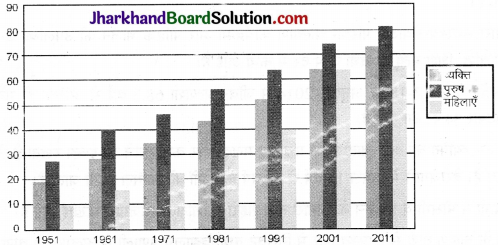

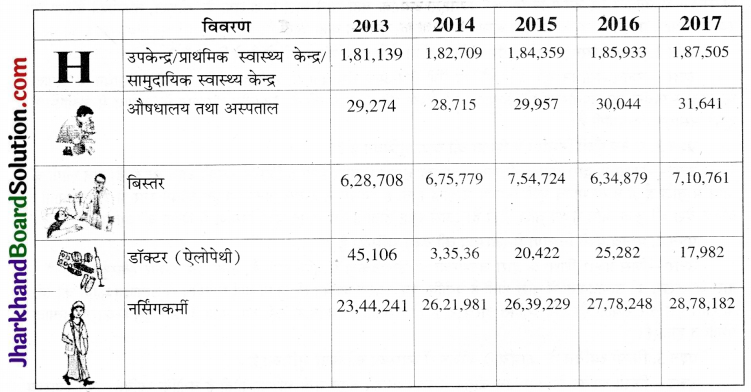
![]()
![]()
![]()
![]()

